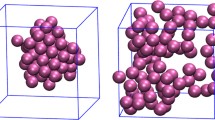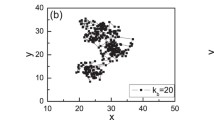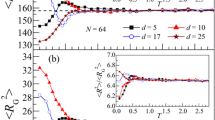Abstract
We study the effect of chain rigidity on tailoring the nanoparticle locations for neutral and selective particles embedded in the lamellar morphology formed by semiflexible diblock copolymer chains using self-consistent field calculations. The nanoparticles are modeled through a cavity function, and the semiflexible chains are represented by the continuous Kratsky-Porod chain model. In general situation, the nanoparticles prefer to stay at the interface in order to reduce the interface areas and thus the system free energy. However, the particle distribution at the domain center is subtle, and the underlying physics is intrinsically different depending on the polymer flexibility. In the case of flexible chains, the entropy just contributes a constant shift to the free energy when the nanoparticles move around the domain center indicating that the local metastable state if appears at the domain center is wholly attributed to the local minimum in the enthalpy. If the polymers are rigid, the variation of the particle distribution at the domain center has a close relation with the polymer rigidity and nanoparticle size. In the case of strongly rigid polymers with small nanoparticles, a nearly uniform particle distribution at the domain center is observed, while in other cases, a local enhancement of particle distribution there is found. In contrast to the case of flexible chains, further analysis reveals the crucial role of entropy in controlling the shape of particle distributions at the phase domain. Specifically, the local metastable state appears in the domain center is determined by the large entropy there which arises from the weak coupling of bond orientations that allows the polymer chains to be relatively relaxed. When the particle becomes selective, its distribution in the phase domain exhibits a shift almost uniformly rather than changes its profile, and the underlying physics still holds. In all, our study establishes a strong coupling between the chain rigidity and effect of entropy.
Similar content being viewed by others
References
Al-Saleh, M. H. Influence of polymer structure on the electrical resistivity of nanocomposite materials. Synth. Met. 2020, 256, 116409.
Yang, Y.; He, J. L.; Li, Q.; Gao, L.; Hu, J.; Zeng, R.; Qin, J.; Wang, S. X.; Wang, Q. Self-healing of electrical damage in polymers using superparamagnetic nanoparticles. Nat. Nanotechnol. 2018, 14, 151–155.
Huang, Y.; Ellingford, C.; Bowen, C.; McNally, T.; Wu, D.; Wan, C. Y. Tailoring the electrical and thermal conductivity of multi-component and multi-phase polymer composites. Int. Mater. Rev. 2019, 65, 129–163.
Bockstaller, M. R.; Thomas, E. L. Proximity effects in self-organized binary particle-block copolymer blends. Phys. Rev. Lett. 2004, 93, 166106.
Wang, Y.; Liu, X.; Li, S.; Li, T.; Song, Y.; Li, Z.; Zhang, W.; Sun, J. Transparent, healable elastomers with high mechanical strength and elasticity derived from hydrogen-bonded polymer complexes. ACS Appl. Mater. Interfaces 2017, 9, 29120–29129.
Yang, Q.; Ye, C.; Zhao, J.; Chen, D.; Weng, B.; You, J.; Li, Y. Shape memory polymers with interconnected nanopores and high mechanical strength. J. Polym. Sci., Part B: Polym. Chem. 2017, 56, 125–130.
Sharma, U.; Concagh, D.; Core, L.; Kuang, Y.; You, C.; Pham, Q.; Zugates, G.; Busold, R.; Webber, S.; Merlo, J.; Langer, R.; Whitesides, G. M.; Palasis, M. The development of bioresorbable composite polymeric implants with high mechanical strength. Nat. Mater. 2017, 17, 96–103.
Bosquetti, M.; da Silva, A. L.; Azevedo, E. C.; Berti, L. F. Analysis of the mechanical strength of polymeric composites reinforced with sisal fibers. J. Nat. Fibers 2019, 18, 105–110.
Zhao, X.; Liu, J.; Li, J.; Liang, Z.; Zhou, W.; Peng, S. Strategies and techniques for improving heat resistance and mechanical performances of poly(lactic acid) (PLA) biodegradable materials. Int. J. Biol. Macromol. 2022, 218, 115–134.
Peelman, N.; Ragaert, P.; Ragaert, K.; Erkoç, M.; Brempt, W. V.; Faelens, F.; Devlieghere, F.; Meulenaer, B. D.; Cardon, L. Heat resistance of biobased materials, evaluation and effect of processing techniques and additives. Polym. Eng. Sci. 2017, 58, 513–520.
Ozerin, S. A.; Vdovichenko, A. Y.; Streltsov, D. R.; Davydov, A. B.; Orekhov, A. S.; Vasiliev, A. L.; Zubavichus, Y. V.; Grigoriev, E. I.; Zavyalov, S. A.; Oveshnikov, L. N.; Aronzon B. A.; Chvalun, S. N. Structure and magnetic properties of Ni-poly(p-xylylene) nanocomposites synthesized by vapor deposition polymerization. J. Phys. Chem. Solids 2017, 111, 245–253.
Barrera, G.; Tiberto, P.; Allia, P.; Bonelli, B.; Esposito, S.; Marocco, A.; Pansini, M.; Leterrier, Y. Magnetic properties of nanocomposites. Appl. Sci. 2019, 9, 212.
Sanida, A.; Stavropoulos, S. G.; Speliotis, T.; Psarras, G. C. Investigating the effect of Zn ferrite nanoparticles on the thermomechanical, dielectric and magnetic properties of polymer nanocomposites. Materials 2019, 9, 3015.
Balazs, A. C.; Emrick, T.; Russell, T. P. Nanoparticle polymer composites: where two small worlds meet. Science 2006, 314, 1107–1110.
Harijan, M.; Singh, M. Zwitterionic polymers in drug delivery: A review. J. Mol. Recognit. 2021, 35, e2944.
Li, M.; Zhang, W.; Li, J.; Qi, Y.; Peng, C.; Wang, N.; Fan, H.; Li, Y. Zwitterionic polymers: addressing the barriers for drug delivery. Chin. Chem. Lett. 2023, 108177.
Fu, X.; Hosta-Rigau, L.; Chandrawati, R.; Cui, J. Multi-stimuli-responsive polymer particles, films, and hydrogels for drug delivery. Chem 2018, 4, 2084–2107.
Kolate, A.; Baradia, D.; Patil, S.; Vhora, I.; Kore, G.; Misra, A. PEG — A versatile conjugating ligand for drugs and drug delivery systems. J. Control. Rel. 2014, 192, 67–81.
Jeon, S. J.; Yang, S. M.; Kim, B. J.; Petrie, J. D.; Jang, S. G.; Kramer, E. J.; Pine, D. J.; Yi, G. R. Hierarchically structured colloids of diblock copolymers and Au nanoparticles. Chem. Mater. 2009, 21, 3739–3741.
Nuopponen, M.; Tenhu, H. Gold nanoparticles protected with pH and temperature-sensitive diblock copolymers. Langmuir 2007, 23, 5352–5357.
Kim, B. J.; Fredrickson, G. H.; Hawker, C. J.; Kramer, E. J. Nanoparticle surfactants as a route to bicontinuous block copolymer morphologies. Langmuir 2007, 23, 7804–7809.
Jang, J.; Li, X. L.; Oh, J. H. Facile fabrication of polymer and carbon nanocapsules using polypyrrole core/shell nanomaterials. Chem. Commun. 2004, 794.
Hamdoun, B.; Ausserré, D.; Joly, S.; Gallot, Y.; Cabuil, V.; Clinard, C. New nanocomposite materials. Journal de Physique II 1996, 6, 493–501.
Lauter-Pasyuk, V.; Lauter, H. J.; Ausserre, D.; Gallot, Y.; Cabuil, V.; Hamdoun, B.; Kornilov, E. I. Neutron reflectivity studies of composite nanoparticle - copolymer thin films. Phys. B Condens. Matter 1998, 248, 243–245.
Dong, B.; Guo, R.; Yan, L. T. Coassembly of Janus nanoparticles in asymmetric diblock copolymer scaffolds: unconventional entropy effect and role of interfacial topology. Macromolecules 2014, 47, 4369–4379.
Tabedzki, C.; Krook, N. M.; Murray, C. B.; Composto, R. J.; Riggleman, R. A. Effect of graft length and matrix molecular weight on string assembly of aligned nanoplates in a lamellar diblock copolymer. Macromolecules 2022, 55, 3166–3175.
Aviv, Y.; Altay, E.; Fink, L.; Raviv, U.; Rzayev, J.; Shenhar, R. Quasi-two-dimensional assembly of bottlebrush block copolymers with nanoparticles in ultrathin films: combined effect of graft asymmetry and nanoparticle size. Macromolecules 2018, 52, 196–207.
Hamley, I. W. Developments in block copolymer science and technology, Wiley, New York, 2004.
Bates, F. S. Block copolymers - designer soft materials. Physics Today 1999, 52, 32–38.
Bates, F. S.; Hillmyer, M. A.; Lodge, T. P.; Bates, C. M.; Delaney, K. T.; Fredrickson, G. H. Multiblock polymers: Panacea or Pandora’s box? Science 2012, 336, 434–440.
Leibler, L. Theory of microphase separation in block copolymers. Macromolecules 1980, 13, 1602–1617.
Chiu, J. J.; Kim, B. J.; Kramer, E. J.; Pine, D. J. Control of nanoparticle location in block copolymers. J. Am. Chem. Soc. 2005, 127, 5036–5037.
Gu, J.; Zhang, R.; Zhang, L.; Lin, J. Epitaxial assembly of nanoparticles in a diblock copolymer matrix: precise organization of individual nanoparticles into regular arrays. Macromolecules 2021, 54, 2561–2573.
Bockstaller, M. R.; Mickiewicz, R. A.; Thomas, E. L. Block copolymer nanocomposites: perspectives for tailored functional materials. Adv. Mater. 2005, 17, 1331–1349.
Zhang, L.; Lin, J.; Lin, S. Self-Assembly behavior of amphiphilic block copolymer/Nanoparticle mixture in dilute solution studied by self-consistent-field theory/density functional theory. Macromolecules 2007, 40, 5582–5592.
Jin, J.; Wu, J.; Frischknecht, A. L. Modeling microscopic morphology and mechanical properties of block copolymer/nanoparticle composites. Macromolecules 2009, 42, 7537–7544.
Lindsay, B. J.; Composto, R. J.; Riggleman, R. A. Equilibrium field theoretic study of nanoparticle interactions in diblock copolymer melts. J. Phys. Chem. B 2019, 123, 9466–9480.
Matsen, M. W.; Thompson, R. B. Particle Distributions in a block copolymer nanocomposite. Macromolecules 2008, 41, 1853–1860.
Jiang, Y.; Zhang, W. Y.; Chen, J. Z. Y. Dependence of the disorder-lamellar stability boundary of a melt of asymmetric wormlike AB diblock copolymers on the chain rigidity. Phys. Rev. E 2011, 84, 041803.
Jiang, Y.; Chen, J. Z. Y. Influence of chain rigidity on the phase behavior of wormlike diblock copolymers. Phys. Rev. Lett. 2013, 110, 138305.
Uchida, K.; Mita, K.; Yamamoto, S.; Tanaka, K. Local orientation of polystyrene at the interface with poly(methyl methacrylate) in block copolymer. ACS Macro Lett. 2020, 9, 1576–1581.
Aldaye, F. A.; Palmer, A. L.; Sleiman, H. F. Assembling materials with DNA as the guide. Science 2008, 321, 1795–1799.
Zhou, C.; Duan, X.; Liu, N. DNA-nanotechnology-enabled chiral plasmonics: from static to dynamic. Acc. Chem. Res. 2017, 50, 2906–2914.
Spakowitz, A. J.; Wang, Z. G. End-to-end distance vector distribution with fixed end orientations for the wormlike chain model. Phys. Rev. E 2005, 72, 041802.
Kratky, O.; Porod, G. Röntgenuntersuchung gelöster Fadenmoleküle. Recueil des Travaux Chimiques des Pays-Bas 1949, 68, 1106–1122.
Saitô, N.; Takahashi, K.; Yunoki, Y. The statistical mechanical theory of Stiff chains. J. Phys. Soc. Jpn. 1967, 22, 219–226.
Chen, Y.; Zhang, X.; Jiang, Y. The influence of side-chain conformations on the phase behavior of bottlebrush block polymers. Soft Matter 2020, 16, 8047–8056.
Matsen, M. W. Melts of semiflexible diblock copolymer. J. Chem. Phys. 1996, 104, 7758–7764.
Vorselaars, B.; Kim, J. U.; Chantawansri, T. L.; Fredrickson G. H.; Matsen, M. W. Self-consistent field theory for diblock copolymers grafted to a sphere. Soft Matter 2011, 7, 5128–5137.
Thompson, R. B.; Rasmussen, K. O.; Lookman, T. Improved convergence in block copolymer self-consistent field theory by Anderson mixing. J. Chem. Phys. 2004, 120, 31–34.
Matsen, M. W. Fast and accurate SCFT calculations for periodic block-copolymer morphologies using the spectral method with Anderson mixing. Eur. Phys. J. E 2009, 30, 361.
Bockstaller, M. R.; Lapetnikov, Y.; Margel, S.; Thomas, E. L. Size-selective organization of enthalpic compatibilized nanocrystals in ternary block copolymer/particle mixtures. J. Am. Chem. Soc. 2003, 125, 5276–5277.
Thompson, R. B.; Ginzburg, V. V.; Matsen, M. W.; Balazs, A. C. Predicting the mesophases of copolymer-nanoparticle composites. Science 2001, 292, 2469–2472.
Acknowledgments
This work was financially supported by the National Natural Science Foundation of China (No. 22173002). S.Q. acknowledges the Fundamental Research Funds for the Central Universities (No. YWF-22-K-101). J.Y. acknowledges the Fundamental Research Funds for the Central Universities from Beihang University. The SCF calculations were carried out on the high performance computer cluster at Beihang University.
Author information
Authors and Affiliations
Corresponding authors
Ethics declarations
The authors declare no interest conflict.
Rights and permissions
About this article
Cite this article
Chen, Y., Qi, S. & Jiang, Y. Particle Distribution Informed by Chain Rigidity in Diblock Copolymer Melts: The Effect of Entropy. Chin J Polym Sci 42, 388–399 (2024). https://doi.org/10.1007/s10118-023-3053-9
Received:
Accepted:
Published:
Issue Date:
DOI: https://doi.org/10.1007/s10118-023-3053-9




